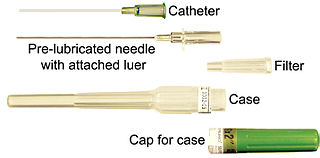Taps and dies are tools used to create screw threads, which is called threading. Many are cutting tools; others are forming tools. A tap is used to cut or form the female portion of the mating pair. A die is used to cut or form the male portion of the mating pair. The process of cutting or forming threads using a tap is called tapping, whereas the process using a die is called threading.
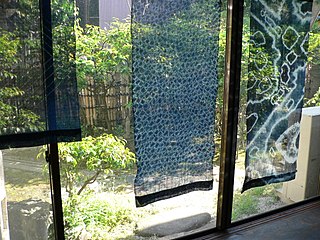
Shibori is a Japanese manual resist dyeing technique, which produces patterns on fabric.

Threading is a method of hair removal originating in Iran, India, Central Asia and China. In more recent times it has gained popularity in Western countries, especially with a cosmetic application.

In rock climbing, a nut is a metal wedge threaded on a wire and is used for protection by wedging it into a crack in the rock. Quickdraws are clipped to the nut wire by the ascending climber and the rope threads through the quickdraw. Nuts come in a variety of sizes and styles, and several different brands are made by competing manufacturers. Most nuts are made of aluminum. Larger nuts may be threaded on Dyneema cord instead of wire, but this has become unusual.
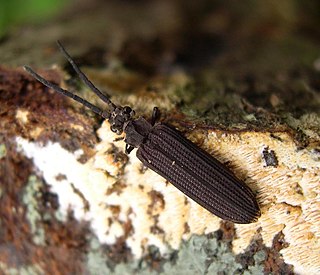
The Archostemata are the smallest suborder of beetles, consisting of fewer than 50 known species organised into five families. They are an ancient lineage with a number of primitive characteristics. They are similar in morphology to the first beetles, which appear in the fossil record about 250 million years ago. Antennae may be thread-shaped (filiform) or like a string of beads (moniliform). This suborder also contains the only paedogenic beetles, Micromalthus debilis.
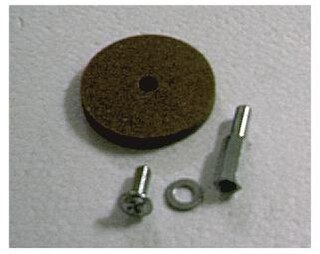
A mandrel is one of the following:

Sculpture is a feature of many of the shells of mollusks. It is three-dimensional ornamentation on the outer surface of the shell, as distinct from either the basic shape of the shell itself or the pattern of colouration, if any. Sculpture is a feature found in the shells of gastropods, bivalves, and scaphopods. The word "sculpture" is also applied to surface features of the aptychus of ammonites, and to the outer surface of some calcareous opercula of marine gastropods such as some species in the family Trochidae.

A spindle is a straight spike usually made from wood used for spinning, twisting fibers such as wool, flax, hemp, cotton into yarn. It is often weighted at either the bottom, middle, or top, commonly by a disc or spherical object called a whorl, but many spindles exist that are not weighted by a whorl, but by thickening their shape towards the bottom, such as Orenburg and French spindles. The spindle may also have a hook, groove, or notch at the top to guide the yarn. Spindles come in many different sizes and weights depending on the thickness of the yarn one desires to spin.

Goldwork is the art of embroidery using metal threads. It is particularly prized for the way light plays on it. The term "goldwork" is used even when the threads are imitation gold, silver, or copper. The metal wires used to make the threads have never been entirely gold; they have usually been gold-coated silver (silver-gilt) or cheaper metals, and even then the "gold" often contains a very low percent of real gold. Most metal threads are available in silver and sometimes copper as well as gold; some are available in colors as well. A new coating technology however enables the direct coating of 24K gold on a filament yarn without any other metal or adhesive layer underneath.
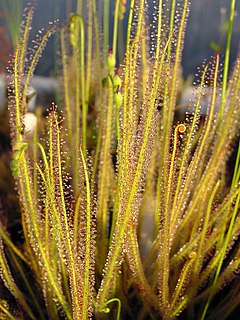
Drosera filiformis, commonly known as the thread-leaved sundew, is a small, insectivorous, rosette-forming species of perennial herb. A species of sundew, it is unusual within its genus in that the long, erect, filiform (thread-like) leaves of this plant unroll in spirals – an arrangement similar to the circinate vernation seen in ferns.

A nut is a type of fastener with a threaded hole. Nuts are almost always used in conjunction with a mating bolt to fasten multiple parts together. The two partners are kept together by a combination of their threads' friction, a slight stretching of the bolt, and compression of the parts to be held together.

Cymbalophora pudica, the discrete chaperon, is a moth of the family Erebidae. The species was first described by Eugenius Johann Christoph Esper in 1784.

Acicular, in mineralogy, refers to a crystal habit composed of slender, needle-like crystals. Crystals with this habit tend to be fragile. Complete, undamaged acicular specimens are uncommon.
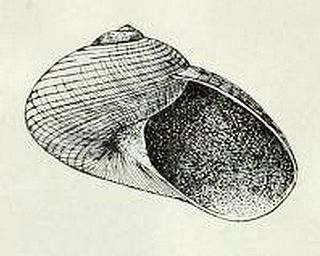
Margarites albolineatus is a species of sea snail, a marine gastropod mollusk in the family Margaritidae, the turban snails.

Lingual papillae are the small, nipple-like structures on the upper surface of the tongue that give it its characteristic rough texture. The four types of papillae on the human tongue have different structures and are accordingly classified as circumvallate, fungiform, filiform, and foliate. All except the filiform papillae are associated with taste buds.
Fodina pallula is a moth of the family Noctuidae first described by Achille Guenée in 1852. It is found in India and Sri Lanka.

Amblychia hymenaria is a moth of the family Geometridae first described by Achille Guenée in 1858. It is found in India, Singapore, Sundaland, Sulawesi, Nepal, Bangladesh, Malaysia and may be in Sri Lanka.
Chlorochaeta integranota is a moth of the family Geometridae first described by George Hampson in 1893. It is found in Sri Lanka and South India.
Callopistria thalpophiloides is a moth of the family Noctuidae first described by Francis Walker in 1862. It is found in the Indian subregion, Sri Lanka, Sundaland, China, Taiwan, Philippines, Sulawesi and New Guinea.
Naarda gigaloba is a moth of the family Erebidae first described by Balázs Tóth and László Aladár Ronkay in 2015. It is found in Sri Lanka.
